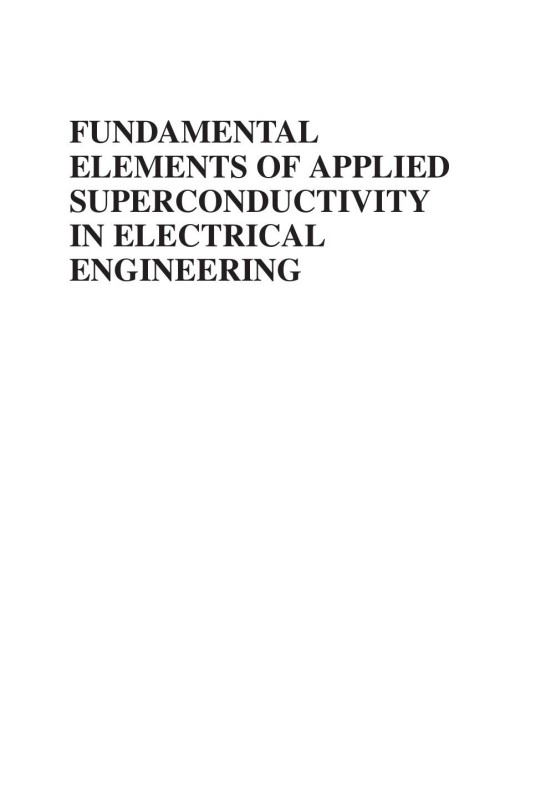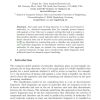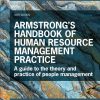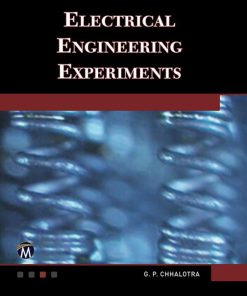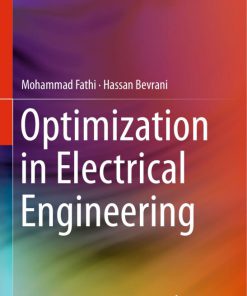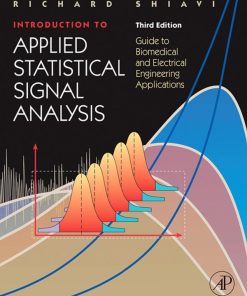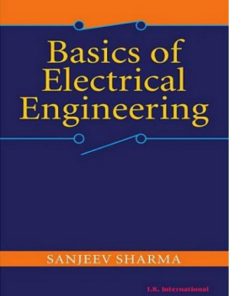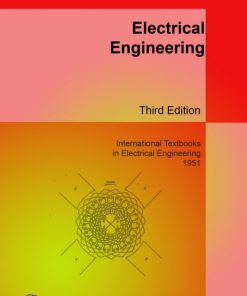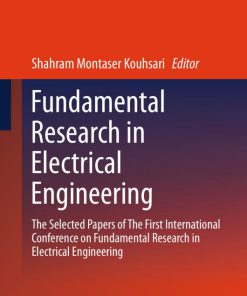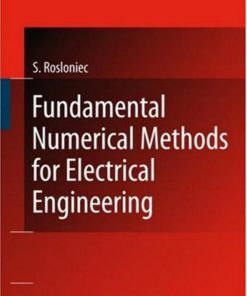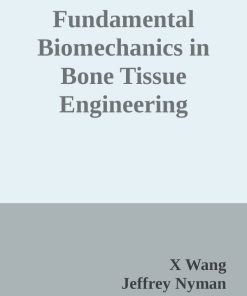(Ebook PDF) FUNDAMENTAL ELEMENTS OF APPLIED SUPERCONDUCTIVITY IN ELECTRICAL ENGINEERING 1st edition by Yinshun Wang 1118451163 9781118451168 full chapters
$50.00 Original price was: $50.00.$25.00Current price is: $25.00.
Authors:Yinshun Wang , Series:Electrical Engineering [201] , Author sort:Wang, Yinshun , Languages:Languages:eng , Published:Published:Jun 2013 , Publisher:Wiley
FUNDAMENTAL ELEMENTS OF APPLIED SUPERCONDUCTIVITY IN ELECTRICAL ENGINEERING 1st edition by Yinshun Wang – Ebook PDF Instant Download/DeliveryISBN: 1118451163, 9781118451168
Full download FUNDAMENTAL ELEMENTS OF APPLIED SUPERCONDUCTIVITY IN ELECTRICAL ENGINEERING 1st edition after payment.
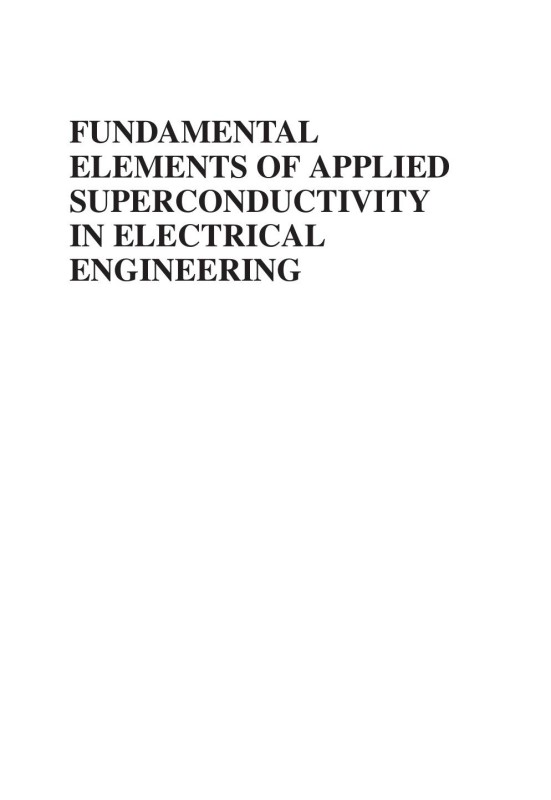
Product details:
ISBN-10 : 1118451163
ISBN-13 : 9781118451168
Author : Yinshun Wang
Superconducting technology is potentially important as one of the future smart grid technologies. It is a combination of superconductor materials, electrical engineering, cryogenic insulation, cryogenics and cryostats. There has been no specific book fully describing this branch of science and technology in electrical engineering. However, this book includes these areas, and is essential for those majoring in applied superconductivity in electrical engineering.
FUNDAMENTAL ELEMENTS OF APPLIED SUPERCONDUCTIVITY IN ELECTRICAL ENGINEERING 1st Table of contents:
1 Introduction
References
2 Superconductivity
2.1 The Basic Properties of Superconductors
2.1.1 Zero-Resistance Characteristic
2.1.2 Complete Diamagnetism – Meissner Effect
2.1.3 Josephson Effects
2.2 Critical Parameters
2.2.1 Critical Temperature Tc
2.2.2 Critical Field Hc
2.2.3 Critical Current Density Jc
2.3 Classification and Magnetization
2.3.1 Coherence Length
2.3.2 Classifications
2.3.3 Type I Superconductor and Magnetization
2.3.4 Type II Superconductor and Magnetization
2.4 Measurement Technologies of Critical Parameters
2.4.1 Cryogenic Thermometers
2.4.2 Measurement of Critical Temperature
2.4.3 Measurement of Critical Current Ic
2.4.4 Measurement of Critical Magnetic Field
References
3 Mechanical Properties and Anisotropy of Superconducting Materials
3.1 Mechanical Properties
3.1.1 General Description of Mechanical Properties
3.1.2 Tensile Properties
3.1.3 Bending Properties
3.2 Electromagnetic Anisotropy
3.2.1 Anisotropy of Critical Current in HTS Materials
3.2.2 Anisotropy of Critical Current in 1G HTS Tape
3.2.3 Anisotropy of Critical Current in 2G HTS Tape
3.2.4 Anisotropy of Critical Current in Bi-2212 Wire
3.2.5 Anisotropy of n Value for HTS Tape
3.2.6 Anisotropy of Critical Current Density in HTS Bulk
3.3 Critical Current Characteristics of LTS Materials
3.3.1 Dependence of Critical Current Density of NbTi on Magnetic Field
3.3.2 Dependence of Critical Current Density of NbTi on Magnetic Field and Temperature
3.3.3 Dependence of Critical Current Density of Nb3Sn on Magnetic Field
3.4 Irreversible Fields of Superconducting Materials
3.5 Critical Temperature of Several Kinds of HTS Materials
3.6 Thermodynamic Properties of Practical Superconducting Materials
3.6.1 Thermal and Mechanical Characteristics of Practical Superconducting Materials
3.6.2 Thermal Contraction of Superconducting Materials
References
4 Stability of Superconductors
4.1 Critical States
4.2 Adiabatic Stabilization
4.3 Adiabatic Stability with Flux Jump
4.4 Self-Field Stability
4.5 Dynamic Stability
4.5.1 Stability of Composite Superconducting Slab with Cooled Side
4.5.2 Stability of Composite Superconducting Slab with Cooled Edge
4.5.3 Dynamic Stability of Current-Carrying Composite Superconductor Slab
4.5.4 Dynamic Stability of Current-Carrying Composite Superconductor with Circular Cross-Section
4.6 Cryostability
4.6.1 Stekly Parameter
4.6.2 One–Dimensional Normal Zone Propagation
4.6.3 Three-Dimensional Normal Propagation Zone and Minimum Quench Energy
4.7 NPZ Velocity in Adiabatic Composite Superconductors
4.7.1 Longitudinal Propagation Velocity
4.7.2 Transverse Propagation Velocity
4.8 Stability of HTS Bulks
4.8.1 Evolution of Super-Current Density
4.8.2 Magnetic Relaxation
4.9 Mechanical Stability of Superconducting Magnets
4.10 Degradation and Training Effect of Superconducting Magnets
4.10.1 Degradation of Superconducting Magnets
4.10.2 Training Effects of Superconducting Magnets
4.11 Quench and Protection of Superconducting Magnets
4.11.1 Resistance Increase and Current Decay in Quench Processes
4.11.2 Factors Causing Quench
4.11.3 Active Protection
4.11.4 Passive Protection
4.11.5 Numerical Simulation on Quench
4.12 Tests of Stability
4.12.1 Flux Jump Experiments
4.12.2 Measurement of Quench Parameters
References
5 AC Losses
5.1 AC Losses of Slab
5.1.1 Slab in Parallel AC Magnetic Field
5.1.2 Slab in Perpendicular AC Magnetic Field
5.1.3 Self-Field Losses
5.1.4 Slab-Carrying DC and AC Currents Located in Parallel DC/AC Magnetic Fields
5.1.5 Slab-Carrying AC and DC Currents
5.1.6 Slab with AC Transport Current in Perpendicular AC Magnetic Field
5.1.7 Slab in AC and DC Magnetic Fields
5.1.8 Flux-Flow Loss of Slab with Combinations of AC and DC Transport Currents in Perpendicular and
5.1.9 Total AC Losses of Slab with any AC/DC Current and AC/DC Magnetic Field
5.2 AC Losses of Concentric Cylinder
5.2.1 Rod in Longitudinal AC Magnetic Field
5.2.2 Rod in Transverse AC Magnetic Field
5.2.3 Rod in Transverse AC Magnetic Field and Carrying DC Transport Current
5.2.4 Rod in Self-Magnetic Field
5.2.5 Rod-Carrying AC Transport Current in AC Transverse Magnetic Field with Same Phase
5.2.6 Flux-Flow Losses of Rod-Carrying AC/DC Transport Currents Subjected to AC/DC Magnetic Field
5.3 AC Losses of Hybrid Concentric Cylinder
5.4 AC Losses of Concentric Hollow Cylinder in Longitudinal Field
5.5 AC Losses for Large Transverse Rotating Field
5.6 AC Losses with Different Phases between AC Field and AC Current
5.6.1 Slab-Carrying Current Exposed to AC Magnetic Field Parallel to its Wide Surface with Different
5.6.2 Slab-Carrying Current Exposed to Parallel AC Magnetic Field at One Side with Different Phases
5.6.3 AC Losses of Slab-Carrying AC Current and Exposed to Symmetrical Parallel AC Magnetic Field wi
5.7 AC Losses for other Waves of AC Excitation Fields
5.8 AC Losses for other Critical State Models
5.8.1 Kim Model
5.8.2 Kim–Anderson Model
5.8.3 Voltage-Current Power-Law Model – Nonlinear Conductor Model
5.8.4 Combination of Kim-Anderson Model and Voltage-Current Power-Law Model
5.9 Other AC Losses
5.9.1 Eddy Current Losses
5.9.2 Penetration Loss in Transverse AC Magnetic Field
5.9.3 Twist Pitch
5.9.4 AC Losses in Longitudinal AC Magnetic Field
5.9.5 Coupling Losses
5.9.6 Measures for Reducing AC Losses
5.10 Measurements of AC Loss
5.10.1 Magnetic Method
5.10.2 Electrical Method
5.10.3 Thermal Method
5.10.4 Comparison of Electrical with Calorimetric Measuring Method
5.11 AC Losses Introduction of Superconducting Electrical Apparatus
References
6 Brief Introduction to Fabricating Technologies of Practical Superconducting Materials
6.1 NbTi Wire
6.2 Nb3Sn Wire
6.2.1 Internal Diffusion Process
6.2.2 External Diffusion Process
6.3 Nb3Al Wire
6.4 MgB2 Wire
6.5 BSCCO Tape/Wire
6.6 YBCO Tape
6.6.1 Substrate and Textured Insulated Layer
6.6.2 Deposition of Superconducting Layer with High Critical Current Density
6.7 HTS Bulk
6.7.1 Melt-Texture-Growth (MTG) Process
6.7.2 Quench-Melt-Growth (MTG) Process/Melt-Powder-Melt-Growth (MPMG) Process
6.7.3 Powder-Melting-Process (PMP)
6.7.4 Melt Cast Process (MCP)
References
7 Principles and Methods for Contact-Free Measurements of HTS Critical Current and n Values
7.1 Measurement Introduction of Critical Current and n Values
7.2 Critical Current Measurements of HTS Tape by Contact-Free Methods
7.2.1 Remanent Field Method
7.2.2 AC Magnetic Field-Induced Method
7.2.3 Mechanical Force Method
7.3 n Value Measurements of HTS Tape by Contact-Free Methods
7.3.1 Hysteretic Loss Component – Varying Amplitude Method
7.3.2 Fundamental Component Method – Varying Frequency
7.3.3 Third Harmonic Component Voltage Method
7.4 Analysis on Uniformity of Critical Current and n Values in Practical Long HTS Tape
7.4.1 Gauss Statistical Method
7.4.2 Weibull Statistical Method
7.5 Next Measurements of Critical Currents and n Values by Contact-Free Methods
References
8 Cryogenic Insulating Materials and Performances
8.1 Insulating Properties of Cryogenic Gas
8.1.1 Insulating Properties of Common Cryogenic Gas
8.1.2 Insulating Properties of Other Gases
8.2 Insulating Characteristics of Cryogenic Liquid
8.2.1 Comparison of Cryogens
8.2.2 Electrical Properties of Cryogens
8.3 Insulating Properties of Organic Insulating Films
8.3.1 Thermodynamic Properties of Organic Films
8.3.2 Resistivity of Organic Films
8.3.3 Permittivity of Organic Films
8.3.4 Dielectric Loss
8.3.5 Breakdown Voltage
8.3.6 Electrical Ageing Characteristics
8.4 Cryogenic Insulating Paints and Cryogenic Adhesive
8.4.1 Epoxy Resin
8.4.2 GE7031 Varnish
8.4.3 Polyvinyl Acetal Adhesive and other Cryogenic Adhesives
8.5 Structural Materials for Cryogenic Insulation
8.5.1 Polymer Materials
8.5.2 Epoxy Resin Composites
8.6 Inorganic Insulating Materials
8.6.1 Thermodynamic Properties of Glasses
8.6.2 Electrical Properties of Ceramics
8.6.3 Thermodynamic and Electrical Properties of Mica Glass
References
9 Refrigeration and Cryostats
9.1 Cryogens
9.2 Cryostat
9.2.1 Cryogenic Thermal Insulation
9.2.2 Basic Classification and Structure of Cryogenic Thermal Insulation
9.2.3 Structure Design of Cryostats
9.2.4 Cryogenic Transfer Lines and Flexible Pipes
9.2.5 Ultra-Cryogenic Cryostat with Dual-Cryostat Structure
9.3 Refrigeration
9.3.1 Principle of Refrigeration and Performance of Refrigerators
9.3.2 Choice of Refrigerator Suitable for Superconducting Power Apparatus
9.4 Cooling Technologies of Superconducting Electric Apparatus
9.4.1 Open-Cycle Cooling
9.4.2 Closed-Cycle Cooling by Reducing Pressure
9.4.3 Closed-Cycle Cooling by Refrigerator
9.4.4 Forced-Flow Circulation Cooling
9.4.5 Direct Cooling by Refrigerator
References
10 Power Supplying Technology in Superconducting Electrical Apparatus
10.1 Current Leads
10.1.1 Conduction-Cooled Current Leads
10.1.2 Approximate Design of Conduction-Cooled Current Lead
10.1.3 Demountable Current Leads
10.1.4 Gas-Cooled Current Leads
10.1.5 HTS Current Leads
10.1.6 Peltier Thermoelectric (TE) Effect
10.1.7 Gas-Cooled Peltier Current Leads (PCL)
10.2 Superconducting Switch
10.2.1 Design of LTS Switch
10.2.2 Design of HTS Switch
10.2.3 Fabrication of Superconducting Switches
10.3 Flux Pump
10.3.1 Principle of Superconducting Flux Pump
10.3.2 Transformer-Type Superconducting Magnetic Flux Pump
10.3.3 HTS Permanent Magnetic Flux Pump
References
11 Basic Structure and Principle of Superconducting Apparatus in Power System
11.1 Cable
11.2 Fault Current Limiter
11.2.1 Classifications
11.2.2 Resistive Type
11.2.3 Saturated Iron Core Type
11.2.4 Transformer Type
11.2.5 Shielded Iron Core Type
11.2.6 Bridge Type
11.2.7 Hybrid Type
11.2.8 Three-Phase Reactance Type
11.3 Transformer
11.3.1 Configuration
11.3.2 Advantages
11.3.3 Further Key Technology
11.4 Rotating Machine-Generator/Motor
11.4.1 Configuration
11.4.2 Advantages
11.4.3 Electric Machine with HTS Bulk
11.4.4 Applications
11.5 Superconducting Magnetic Energy Storage (SMES)
11.5.1 Principle and Basic Topology
11.5.2 Application in Grid System
11.6 Superconducting Flywheel Energy Storage (SFES)
11.6.1 Principle and Structure
11.6.2 Application in Grid System
11.7 Other Industrial Applications
11.7.1 High Magnetic Field
11.7.2 Low Magnetic Field
11.7.3 Maglev Transportation
References
12 Case Study of Superconductivity Applications in Power System-HTS Cable
12.1 Design of AC/CD HTS Cable Conductor
12.1.1 Former Size
12.1.2 Number of Tapes
12.1.3 Number of Layers
12.1.4 Number of Tapes on Layer
12.1.5 Insulation
12.1.6 Shielding and Protection Layers
12.2 Electromagnetic Design of AC/CD Cable Conductor
12.2.1 Range of Winding Angle (Pitch)
12.2.2 Design of CD Cable Conductor
12.3 Analysis on AC Losses of DC HTS Cable
12.3.1 Magnetic Field Analysis
12.3.2 AC Losses of HTS CD Cable Conductor
12.4 Design of AC WD HTS Cable Conductor
12.4.1 Eddy Current Loss in Cryostat
12.4.2 Dielectric Loss
12.5 Design of DC HTS Cable Conductor
12.6 Design of Cryostat
12.7 Manufacture of CD HTS Cable Conductor
12.8 Bending of HTS Cable
12.9 Termination and Joint
12.9.1 Termination
12.9.2 Joint
12.10 Circulating Cooling System and Monitoring System
12.10.1 Cooling System
12.10.2 Monitoring System
People also search for FUNDAMENTAL ELEMENTS OF APPLIED SUPERCONDUCTIVITY IN ELECTRICAL ENGINEERING 1st:
what is superconductor and its application
what elements are superconductors
foundations of applied superconductivity
fundamental concept of superposition
superconducting elements
You may also like…
eBook MOBI
(Ebook PDF) Electrical Engineering Experiments 1st edition by Chhalotra 9781683921158 full chapters

